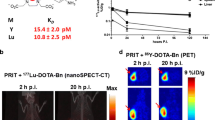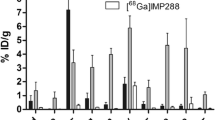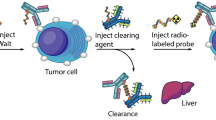Summary
The advantages of bivalent hapten-bearing peptides for the detection of tumours pretargeted with bispecific antibodies have been demonstrated. This technology is now considered for radioimmunotherapy and bivalent haptens designed to target131I are needed. We thus synthesised a series of tyrosine-containing peptides bearing the histamine-hemisuccinate hapten. These molecules were tested for their ability to bind simultaneously two anti-hapten antibody molecules. One of these bivalent haptens, AG3.0, with a lysyl-d-tyrosyl-lysine connecting chain, was found to have optimal binding characteristics and was thus selected for further investigations. AG3.0 was shown to efficiently deliver radioactive iodine to human colorectal tumours grafted in nude mice using an anti-carcinoembryonic antigen×anti-histamine-hemisuccinate bispecific antibody. AG3.0 was also targeted to human B lymphoma cells pretargeted with a bispecific antibody specific for membrane IgM. In this system, bivalent ligands such as F(ab′)2 or IgG are rapidly internalised and covalently linked radioactive iodine is released from target cells as a result of intracellular catabolism. With the pretargeted iodine-labelled bivalent hapten, a fivefold increase in the intracellular activity retention time as compared to125I-labelled F(ab′)2 and IgG was observed. The radiolabelled hapten did not undergo any degradation after internalisation. These results have been confirmed in vivo with an anti-BCL1 IgM idiotype bispecific antibody and131I-labelled AG3.0. These reagents injected as a single 300 μCi dose, 7 days after inoculation of 104 BCL1 lymphoma cells in BALB/c mice, cured 14/16 of the animals and the treatment was well tolerated. Comparatively, the same dose of labelled IgG cured 13/16 of the mice but three mice died of haematologic toxicity. The same dose of labelled F(ab′)2 or Fab′ was completely inefficient.131I-labelled bivalent haptens are now used in phase I radioimmunotherapy clinical trials.
Similar content being viewed by others
References
Schlumberger, M., Tubiana, M., De Vathaire, F., Hill, C., Gardet, P., Travagli, J.P., Fragu, P., Lumbroso, J., Caillou, B. and Parmentier, C., J. Clin. Endocrinol. Metab., 63 (1986) 960.
Kaminski, M.S., Zasadny, K.R., Francis, I.R., Milik, A.W., Ross, C.W., Moon, S.D., Crawford, S.M., Burgess, J.M., Petry, N.A., and Butchko, G.M., New Engl. J. Med., 329 (1993) 459.
Mach, J.P., Pèlegrin, A. and Buchegger, F., Curr. Opin. Immunol., 3 (1991) 685.
Goldenberg, D.M., Am. J. Med., 94 (1993) 297.
Press, O.W., Farr, A.G., Borroz, K.I., Anderson, S.K. and Martin, P.J., Cancer Res., 49 (1989) 4906.
Scheinberg, D.A. and Strand, M., Cancer Res., 43 (1983) 265.
Le Doussal, J.M., Gruaz-Guyon, A., Martin, M., Gautherot, E., Delaage, M. and Barbet, J., Cancer Res., 50 (1990) 3445.
Le Doussal, J.M., Chetanneau, A., Gruaz-Guyon, A., Martin, M., Gautherot, E., Lehur, P.A., Chatal, J.F., Delaage, M. and Barbet, J., J. Nucl. Med., 34 (1993) 1662.
Chetanneau, A., Barbet, J., Peltier, P., Le Doussal, J.M., Gruaz-Guyon, A., Bernard, A.M., Resche, I., Rouvier, E., Bourguet, P., Delaage, M. and Chatal, J.F., Nucl Med Commun., 15 (1994) 972.
Peltier P., Curtet, C., Chatal, J.F., Le Doussal, J.M., Daniel, G., Aillet, G., Gruaz-Guyon, A., Barbet, J. and Delaage, M., J. Nucl. Med., 34 (1993) 1267.
Bardies, M., Bardet, S., Faivre-Chauvet, A., Peltier, P., Douillard, J.Y., Mahe, M., Fiche, M., Lisbona, A., Meyer, P., Gautherot, E., Rouvier, E., Barbet, J. and Chatal, J.F., J. Nucl. Med., 37 (1996) 1853.
Merrifield, R.B., J. Am. Chem. Soc., 85 (1963) 2149.
Salacinsky, P.R.P., McLean, P., Sykes, J.E.C., Clement-Jones, V.V. and Lowry, P.J., Anal. Biochem., 117 (1981) 136.
Morel, A., Darmon, M. and Delaage, M., Mol. Immunol., 27 (1990) 995.
Glennie, M.J., McBride, H.M., Worth, A.T. and Stevenson, G.T., J. Immunol., 139 (1987) 2367.
Dower, S.K., De Lisi, C., Titus, J.A. and Segal, D.M., Biochemistry, 20 (1981) 6326.
Barbet, J., Le Doussal, J.M., Gruaz-Guyon, A., Martin, M., Gautherot, E. and Delaage, M., J. Theoret. Biol., 165 (1993) 321.
Gruaz-Guyon, A., Gras-Masse, H. and Le Doussal, J.M., In Giraldt, E. and Andreu, D. (Eds.) Peptides 1990, ESCOM, Leiden, 1991, pp. 822–825.
Manetti C., Le Doussal, J.M., Rouvier, E., Gruaz-Guyon, A. and Barbet, J., Int. J. Cancer, 63 (1995) 250.
Gautherot, E., Bouhou, J., Loucif, E., Manetti, C., Martin, M., Le Doussal, J.M., Rouvier, E. and Barbet, J., Tumor Target, 2 (1996) 151.
Author information
Authors and Affiliations
Rights and permissions
About this article
Cite this article
de Boisferon, M.H., Manetti, C., Raguin, O. et al. Pretargeted radioimmunotherapy using131I-labelled bivalent hapten-bearing peptides. Lett Pept Sci 4, 331–339 (1997). https://doi.org/10.1007/BF02442897
Received:
Accepted:
Issue Date:
DOI: https://doi.org/10.1007/BF02442897




